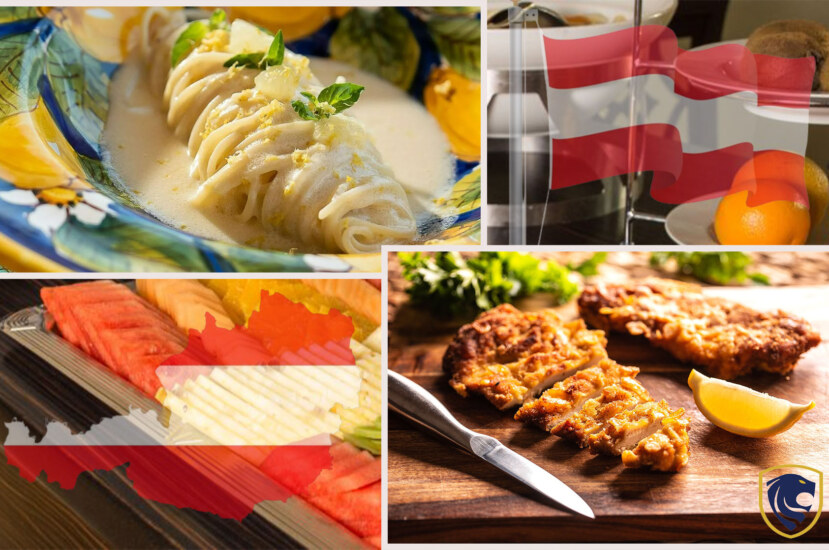The culinary fabric of Austria is a lively mosaic of tastes, with each dish expressing a tale of history and innovation. Austrian food captivates with its rich history and numerous influences, from the center of Vienna to the Alpine getaways. The country’s dedication to culinary perfection is reflected in its renowned meals, which are masterpieces of simplicity and flavor. These culinary jewels are more than just meals; they are a cultural festival, a symphony of textures and aromas that appeal to both residents and visitors. So, in this journey, we go into the heart of Austrian cuisine, discovering the essence of its most traditional meals. From substantial stews to exquisite cakes, each dish embodies the warmth and welcome that distinguish Austrian dining.
Wiener Schnitzel
Wiener Schnitzel is a breaded and fried cutlet, often made of veal or pig. It has a crisp, golden crust that encases juicy flesh and is thin and soft. Moreover, the dish’s name, “Wiener,” refers to its Viennese origins, and it has come to represent Austrian cuisine. The cutlet is pressed thin, then covered in breadcrumbs before being cooked to perfection. As an outcome, the crispy covering contrasts with the delicate meat inside. In addition, the acidity offers a tangy zing when served with a wedge of lemon.

Wiener Schnitzel; Exploring the Rich Culinary Heritage Of Austria
While Wiener Schnitzel may appear easy, its preparation requires accuracy and experience. The meal dates back to the nineteenth century, making it a time-honored favorite. Furthermore, the crispy treat is enjoyed by both locals and visitors, whether in a modest family kitchen or a crowded Viennese cafe. Wiener Schnitzel is more than just a meal in Austria; it’s a cultural symbol. This renowned dish embodies Austrian cuisine, pleasing palates with its timeless and irresistible blend of simplicity and taste.
Sachertorte
Sachertorte, a famous Austrian dessert, is a decadent chocolate cake. Layers of luscious chocolate cake are expertly layered with apricot jam, resulting in a beautiful balance of sweetness and richness. The cake is topped with a glossy chocolate glaze, which adds a delectable touch. This dessert, invented by Franz Sacher in 1832, has become synonymous with Austrian culinary brilliance. Each taste reveals a symphony of textures and aromas, served in exquisite slices. Also, the apricot jam, a unique addition, complements the strong chocolate, providing a delicious surprise.

Sachertorte; Exploring the Rich Culinary Heritage Of Austria
Sachertorte, traditionally served with a dollop of unsweetened whipped cream, has a loyal following. Its iconic prominence goes beyond the boundaries of Austria, making it a global ambassador for Austrian patisserie.
The recipe, which is jealously guarded by the Hotel Sacher in Vienna, guarantees the authenticity of this beloved dish. Tourists go to the old hotel to have a piece, while residents use it to mark key anniversaries. In conclusion, Sachertorte is more than simply a cake; it’s a piece of Austrian history, a tribute to the country’s sweet artistry that continues to enchant palates throughout the world.
Apfelstrudel
Apfelstrudel is a traditional Austrian pastry that is filled with finely sliced apples, cinnamon, and raisins. Each taste is a delicious mix of sweetness and warmth, encased in layers of delicate, flaky pastry. Apfelstrudel dates back centuries and has become a treasured part of Austrian culinary tradition. Also, when served warm, the scent of baked apples and cinnamon fills the air, creating a welcoming mood. The preparation entails expert stretching of the dough to reach the necessary thinness, resulting in a precise balance of filling and pastry. So, Apfelstrudel is a visual and gustatory treat, sometimes sprinkled with powdered sugar.

Apfelstrudel; Exploring the Rich Culinary Heritage Of Austria
This pastry is enjoyed by both locals and visitors, who pair it with a scoop of vanilla ice cream or a dab of whipped cream. Moreover, Apfelstrudel epitomizes the spirit of comfort and tradition in Austrian cuisine, whether served in a modest café or baked at home for a family gathering. Its ageless appeal has resulted in variants all over the world, but the true Apfelstrudel experience is best enjoyed in the quaint cafés of Vienna or amidst the stunning vistas of Austrian countryside. Apfelstrudel is more than simply a dessert; it’s a celebration of the craftsmanship and warmth that are ingrained in Austrian culinary traditions.
Kaiserschmarrn
Kaiserschmarrn is a popular Austrian delicacy that consists of fluffy shredded pancakes. It’s generally served in bite-sized pieces, caramelized to perfection, with a coating of powdered sugar. This dessert or breakfast delight has a deep history and is suited for royalty. Moreover, it has won a place in the hearts and stomachs of Austrians after being named after Emperor Franz Joseph I. Separating the eggs is the first step in making a light and airy batter. The pancake is cooked to golden brown perfection in a skillet before being ripped into lovely, uneven bits. Traditionally, Kaiserschmarrn is served with fruit compote, which provides a sweet contrast to the mild flavor of the pancake. It’s a delightful experience because of the blend of textures and flavors.

Kaiserschmarrn; Exploring the Rich Culinary Heritage Of Austria
Kaiserschmarrn reflects the spirit of Austrian comfort food, whether consumed as a sweet start to the day or as a cozy dessert. It’s a cuisine that encourages social enjoyment, and it’s frequently enjoyed with friends and family. Kaiserschmarrn may be found in both quiet Alpine chalets and stylish city cafés, bridging the gap between tradition and modernity. Its popularity extends beyond Austria, and it has become a symbol of the country’s culinary expertise and gracious hospitality. Kaiserschmarrn offers a narrative of history, luxury, and the ageless delight found in Austrian cuisine in every bite.
Goulash
Goulash, a hearty stew popular in Austria, is a delicious treat. It’s a comforting classic with juicy meat, veggies, and a paprika-infused broth. While originally Hungarian, this dish has blended effortlessly into Austrian cuisine. It represents the country’s numerous culinary influences and has become a household favorite in Austria. The outcome of expert seasoning and patient cooking is a rich, fragrant stew that warms the soul. Also, to soak up the delicious richness, goulash is sometimes served with a side of bread or dumplings. The ingredients’ simplicity—meat, onions, and paprika—belies the depth of tastes. Slow cooking helps the meat to tenderize and the spices to blend, producing a flavor experience.

Goulash; Exploring the Rich Culinary Heritage Of Austria
Goulash represents the essence of comfort cuisine, and is commonly enjoyed in quiet taverns or at home on winter evenings. Its adaptability extends to regional variants, each having their own take on the basic recipe. Goulash has withstood the test of time, crossing boundaries and becoming a treasured staple of Austrian cuisine. A hot bowl of Goulash, whether in Vienna or the Austrian countryside, is a taste of heritage that urges you to experience the rich and powerful tastes of this renowned cuisine.
Tafelspitz
Tafelspitz, a traditional Austrian meal, is boiling beef with horseradish. It is a culinary classic that provides a one-of-a-kind dining experience. The meat is perfectly cooked, producing in soft pieces that virtually melt in your mouth. It’s frequently served with traditional side dishes like potatoes and spinach, and it’s accompanied by a savory broth. Tafelspitz, named after a kind of meat, exemplifies Austrian culinary innovation. Moreover, the recipe is a tribute to simplicity, enabling the beef’s quality to show through. Tafelspitz, which is often consumed in a group environment, draws people together. Its preparation necessitates meticulous attention to detail, resulting in a beautiful balance of flavors and textures.

Tafelspitz; Exploring the Rich Culinary Heritage Of Austria
The horseradish adds a fiery bite to the meal, boosting its overall flavor. Tafelspitz honors the country’s agricultural history, with meat purchased locally for maximum freshness.
Tafelspitz is a perennial favorite, despite its beginnings in the nineteenth century. It’s a dish that reflects the spirit of Austrian dining—wholesome, savory, and savored with good company—whether served in a rustic bar or a classy restaurant. Tafelspitz is an icon of Austrian culinary culture, beckoning both residents and visitors to experience its simple yet delicious flavor.




